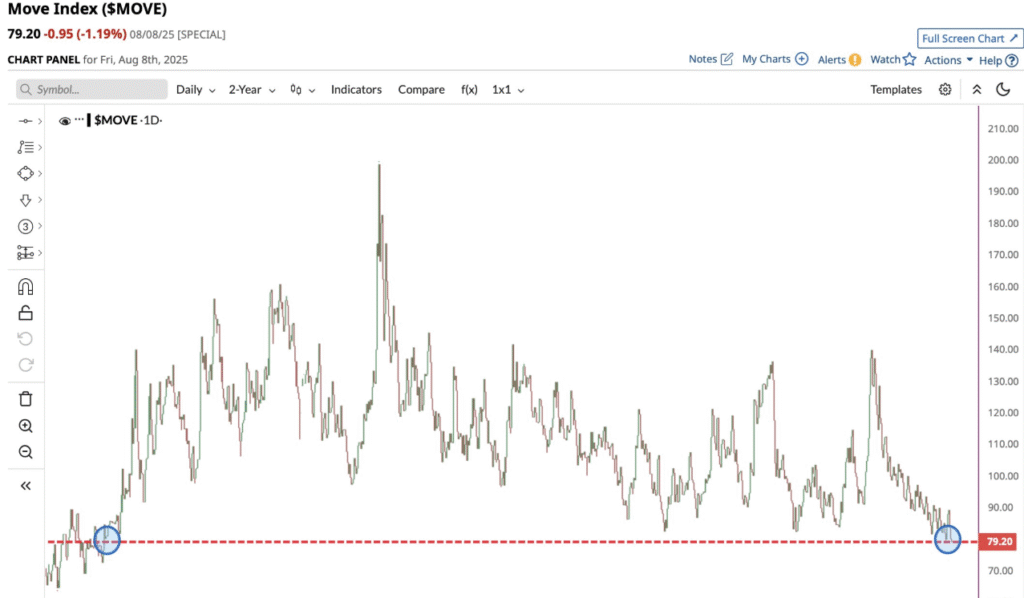The U.S. Treasury MOVE Index has plunged to 79.20, its lowest level since January 2022, signaling unprecedented calm in the bond market. This drop in volatility reflects investor confidence in Federal Reserve policy stability, easing inflation concerns, and a resilient U.S. economy, but history warns that such tranquility can precede sharp market shifts.
U.S. Treasury Volatility Index Falls to Lowest Level Since January 2022
The U.S. Treasury market, often referred to as the world’s most important financial benchmark, is experiencing its calmest conditions in more than three years. The MOVE Index — the market’s key gauge of expected volatility in U.S. Treasury bonds — has dropped to 79.20 as of August 8, 2025, marking its lowest reading since January 2022.
This sharp decline in volatility signals a striking shift in sentiment across global fixed-income markets. The MOVE Index, which tracks implied volatility in the U.S. Treasury market using options on Treasury futures, is often compared to the equity market’s “fear gauge,” the VIX. A low MOVE reading generally reflects stability in interest rate expectations, calmer market conditions, and reduced uncertainty about Federal Reserve policy or macroeconomic shocks.
From Volatility Peaks to Historical Calm
The chart of the MOVE Index over the past two years shows a dramatic transformation. In mid-2022 and through 2023, the index experienced sharp spikes, with peaks above 200, as the Federal Reserve aggressively hiked interest rates to combat surging inflation. Concerns about recession, banking sector instability, and geopolitical tensions kept volatility elevated.

Now, however, the picture is remarkably different. The recent reading of 79.20 marks a clear break below a long-standing support level — the same threshold first reached before the 2022 rate hike cycle began. The fact that Treasury volatility has fallen to this level suggests that traders are increasingly confident about the Fed’s current path, and that bond markets expect interest rates to remain stable in the near term.
Why Treasury Volatility Matters
U.S. Treasury bonds form the backbone of the global financial system, influencing everything from mortgage rates and corporate borrowing costs to global capital flows. The MOVE Index is a critical tool for assessing the risk environment in fixed-income markets.
High U.S. Treasury volatility can trigger ripple effects across equities, credit markets, and currencies. It often leads to risk-off sentiment, prompting investors to cut exposure to risky assets. Conversely, when volatility is low — as it is now — investors tend to take on more risk, pushing money into stocks, high-yield bonds, and emerging markets.
With the MOVE Index hitting multi-year lows, it is clear that U.S. Treasuries are sending a strong “all clear” signal to the broader market.
No Fear Left in the Market?
The current environment reflects a combination of factors:
- Federal Reserve Policy Clarity: After two years of aggressive tightening, the Fed has signaled that it will hold rates steady, with no immediate plans to hike further unless inflation flares up unexpectedly.
- Tamed Inflation Data: Recent inflation reports show price growth returning closer to the Fed’s 2% target, easing fears of renewed rate hikes.
- Stable Economic Outlook: While growth has slowed, the U.S. economy remains resilient, avoiding the deep recession that many predicted.
- Market Positioning: Many institutional investors have already adjusted portfolios for a stable rate environment, reducing the need for hedging and volatility protection.
However, some analysts warn that a period of extremely low volatility can be deceptive. Historically, market calm is often followed by sudden bursts of instability when unexpected events occur. In other words, “no fear” in the Treasury market today doesn’t guarantee smooth sailing tomorrow.
Comparison to Equity Market Sentiment
The MOVE Index’s plunge mirrors similar trends in the equity market’s VIX index, which is also hovering near multi-year lows. Both indicators suggest that traders have grown comfortable with the macroeconomic backdrop. This risk-on sentiment is evident in the strong rally across U.S. stock indexes, with the S&P 500 and Nasdaq both setting fresh record highs in recent weeks.
But the key difference is that Treasury volatility is more directly tied to interest rate expectations and bond market liquidity, making it a purer measure of monetary policy certainty.
What to Watch Ahead
While the MOVE Index suggests extreme calm, several upcoming events could test this stability:
- Economic Data Releases — If inflation surprises to the upside or job market data shows unexpected strength, bond traders may start pricing in renewed Fed action.
- Geopolitical Risks — Escalation in geopolitical tensions, such as conflicts in Eastern Europe or trade disputes, could spark a flight to safety in Treasuries and push volatility higher.
- Fiscal Concerns — Rising U.S. government debt levels and Treasury issuance could impact long-term yields, potentially reigniting volatility.
For now, the U.S. Treasury market appears to be enjoying a rare moment of tranquility, with the MOVE Index breaking below levels not seen since before the Fed’s 2022 rate hike cycle. Traders, portfolio managers, and policymakers alike will be watching closely to see if this low-volatility environment can last — or if history’s lesson of “calm before the storm” will play out again.
Conclusion
The drop of the MOVE Index to 79.20 is more than just a statistical milestone; it reflects a deep shift in market psychology. For investors, this low level of U.S. Treasury volatility represents both an opportunity — with stable rates supporting risk assets — and a potential warning sign, as historically low volatility often precedes periods of turbulence.
Whether this marks the beginning of a sustained era of bond market calm or just a brief pause before the next storm remains to be seen. But for now, the U.S. Treasury market’s message is clear: no fear.

